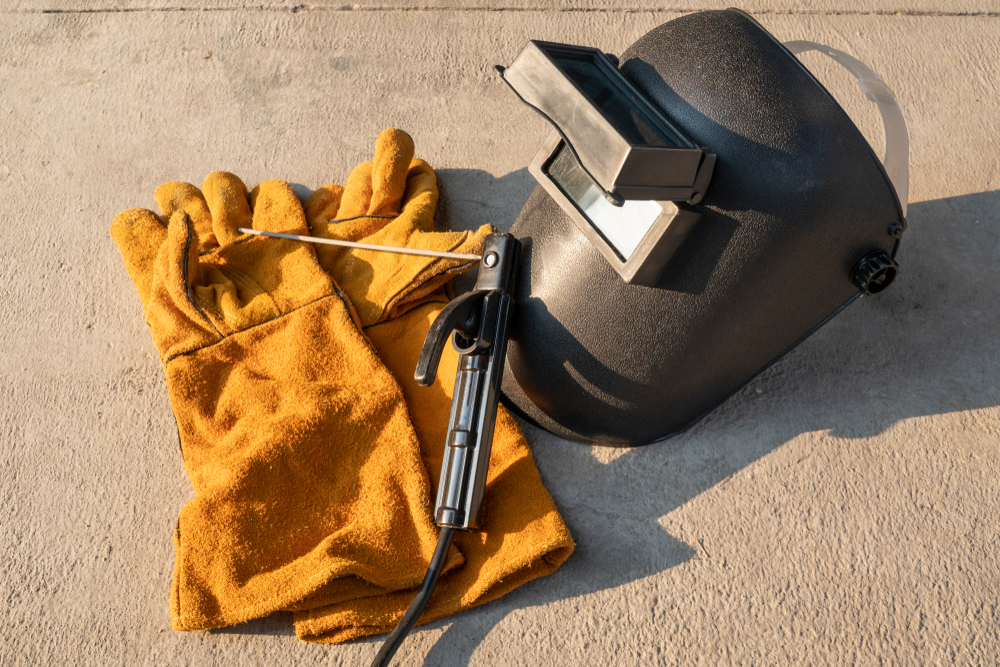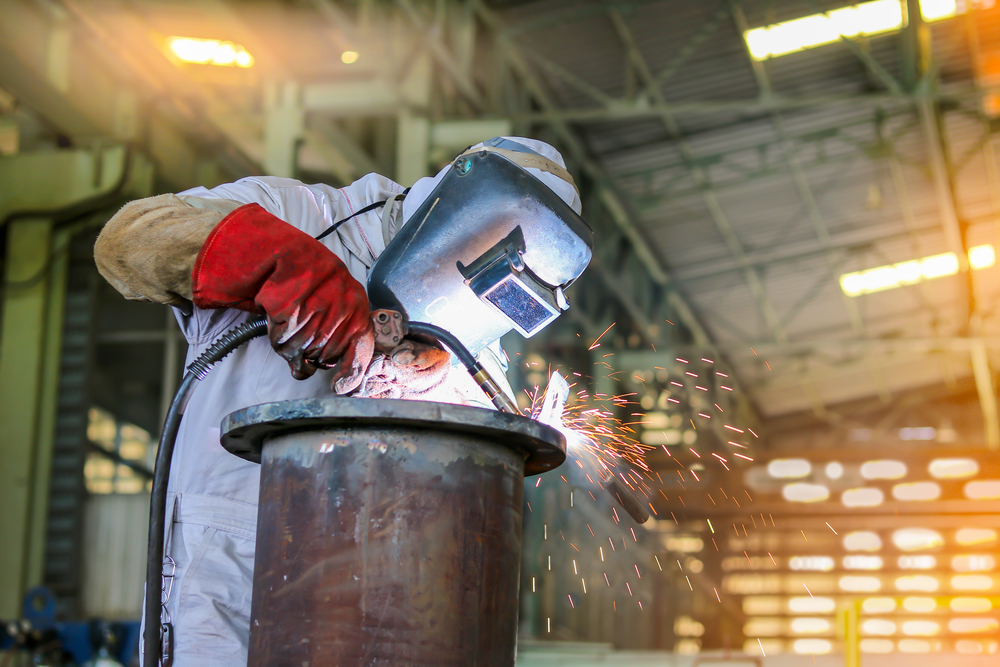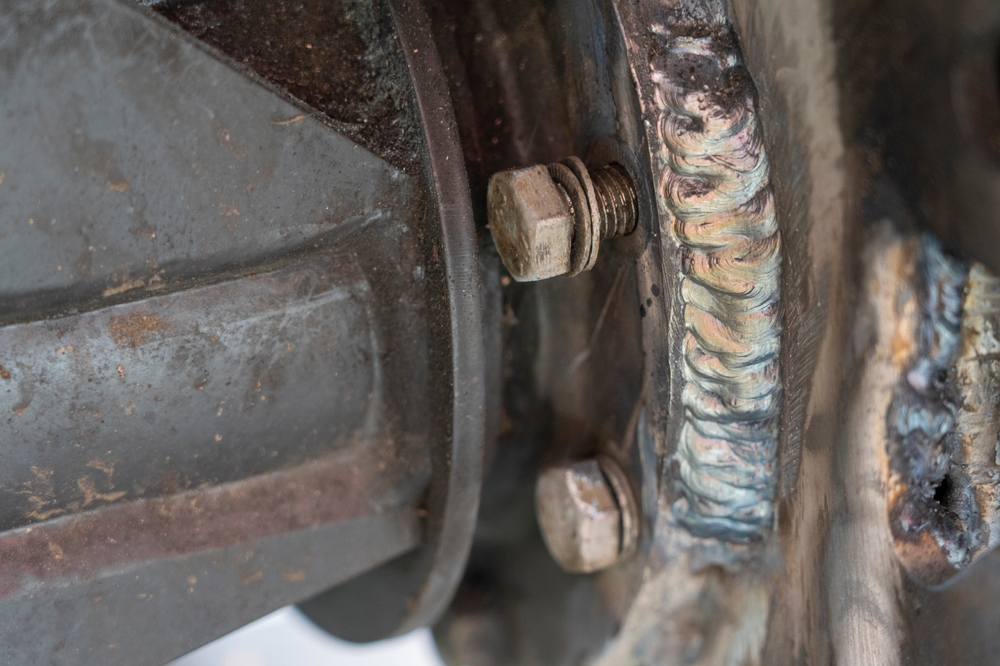Welding is an extremely fundamental aspect of construction or any metalworking project and it is truly amazing how far the technology has come over the years. There have been many advances in terms of capabilities and effectiveness as well as overall general welding safety. However, while great strides have been made in terms of safety, there is still an inherent danger that comes along with welding. The good news though is that with safety firmly at the forefront of welders’ minds there is much they can do to minimize the risk to themselves, coworkers, and property. Let’s take a look at some of the main safety checks that every welder should perform on a daily basis to avoid danger.
Welding Safety Steps To Take Before Welding
Before you ever touch the welding machine there are a number of very important welding safety checks that you should always make it a point to do first. These safety measures may seem like common sense, but it is easy for them to be forgotten or start to become ignored over time because the welding itself might start to feel routine. That is why it is imperative to train yourself to make these steps a daily part of your work schedule.
Know Your Equipment

As we said above, welding technology has come a long way over the years. That means that over time there have been subtle changes to the equipment. In fact even when a new welding machine comes out that does function essentially the same as its predecessors there is still very likely to be at least some subtle changes that the welder must be aware of. Thus, even if you are an extremely experienced welder, always make it a point to be fully familiar with the particular machine you will be using before you begin.
Risk Assessment and Hazard Identification
Every welding operation begins with a critical step: risk assessment. Prior to starting any welding task, it is imperative to assess the environment and the task for potential hazards. This assessment should consider factors such as the materials involved, the type of welding process, environmental conditions, and the proximity to other workers and equipment. Identifying and evaluating these hazards beforehand allows for the implementation of effective control measures, thereby ensuring a safer welding operation.
Welding Equipment Maintenance and Safety
The safety of a welding operation is heavily dependent on the condition and placement of the welding equipment. Regular maintenance of the equipment is essential to ensure it functions correctly and safely. Additionally, strategic placement of welding cables and equipment is crucial to avoid tripping hazards and obstructions in passageways, ladders, and stairways. Over time hoses may begin to leak or wiring may become exposed or frayed. When this happens the chances of an accident rise exponentially, and yet this type of common wear and tear is one of the easiest things for people to overlook. It can feel like your machine is perfectly safe if you were just using it the day before, but rather than jumping right back on it, you must make it a point, each and every time you are about to weld, to visually inspect everything before beginning.
Selecting a Safe Welding Environment
The choice of a welding location is fundamental to ensuring overall welding safety. Prior to initiating any welding activity, it is essential to conduct a thorough evaluation of the surroundings. A safe welding environment is one that is devoid of flammable materials and is situated at a safe distance from potential fire hazards. A minimum distance of 35 feet from flammable objects is recommended. If welding an immovable object, ensure that all movable fire hazards are relocated away from the welding area. This proactive approach to selecting a welding environment significantly reduces the risk of accidents and fires.
Ensuring Adequate Ventilation
Appropriate ventilation is a key element in maintaining a safe welding environment. Effective ventilation systems are necessary to remove harmful fumes and gases from the welder’s breathing zone and prevent the accumulation of combustible gases or vapors. Before commencing any welding activity, it is vital to check that the ventilation systems are functioning properly and are adequate for the specific welding task. This not only ensures the welder’s immediate safety but also protects against long-term health hazards.
Check Your Work Area
By its nature, welding produces hazardous fumes. These fumes can be extremely dangerous to workers and others in the area, and it is essential that people are not exposed to them for prolonged periods of time. That is why it is very important to be sure that your welding area is well ventilated before you begin work. If you are not welding in an open, naturally well-ventilated area, then you must be sure that there is a functioning mechanical ventilation system in place that will be clearing away the dangerous fumes.
Safety Measures for Non-Welding Personnel
The safety of individuals in the vicinity of welding operations is as important as that of the welders. After completing welding tasks, it is the welder’s responsibility to mark hot metals and provide effective means of warning to other workers. This could include physical barriers, signs, or verbal warnings. Such measures are crucial to prevent accidental contact with hot surfaces or materials, thereby reducing the risk of burns and other injuries to non-welding personnel.
It is also imperative that you evaluate your work area itself to determine if it is a safe environment for welding. Make sure that there are no flammable materials nearby. For example in many shops and workplaces one potential culprit is degreasing solvent. This substance certainly has an important role to fill, but you must be certain that no remnants are left behind in your work area before you begin welding.
Consider The Material You Will Be Welding
It is very important to be aware of what type of material you will be dealing with before you begin welding on it. Not only will this affect the welding process itself, but you could be dealing with something that is more dangerous or tricky than you realize. For example does the item to be welded have any kind of surface coating that might be flammable or which might produce toxic gases? Has the welding surface been exposed to flammable chemicals which may have left a residue? Remember that before you begin welding you must ensure that your welding surface is actually safe for welding.
Have Emergency Precautions In Place
It is impossible to completely plan for and anticipate an accident. If you could know for a fact that an accident was coming then obviously you could prevent it from happening in the first place. Due to their unexpected nature, it is of the essence that you prepare for an emergency situation before one ever arrives. That means knowing where the nearest fire extinguisher is located, where fire alarms and fire exits are located, as well as ensuring that there is reliable access to a phone that can be used in an emergency situation. You should also be aware of all welding safety and emergency protocols that your particular worksite has in place.
Inform Others About Your Work
The flash from welding can cause serious, painful damage to the human eye. Sparks and fumes also pose a significant risk. With proper preparation, the person doing the welding should be prepared for these hazards and should be ready to meet them safely. However, that will most likely not be the case for someone who happens to unknowingly walk by while you are welding. To protect your coworkers and other visitors to the worksite from these dangers it is imperative that you warn people before you begin welding so that they can clear the area or take the necessary safety precautions.
Ongoing Training and Awareness
Staying informed and updated is a critical component of welding safety. Welders should regularly review and understand the warning labels and safety data sheets associated with the materials and equipment they use. Additionally, ongoing training is essential to stay abreast of new techniques, equipment, and safety standards. This continuous learning approach ensures that welders are always equipped with the knowledge and skills necessary to maintain a safe working environment.

Welding Safety Steps To Take While Welding
Once you have taken care of all of the business listed above, it’s time to begin welding. However. safe welding involves a lot more than simply the actual welding itself. There are still several things which you should be doing to minimize your risk.
Wear The Proper Safety Gear
Perhaps the single most important components is to wear the proper safety gear. This includes a suitable welding helmet which will protect your eyes from the flash, while also protecting your face, hair, and skin from sparks, spatter, and other dangerous debris. You should also be wearing a flameproof apron as well as flameproof gauntlet gloves. Don’t forget about your feet either. In order to avoid painful, dangerous injuries you should wear high-top shoes or boots which fully cover and protect your feet. Lastly, remember to wear dry, properly fitting clothing. Clothing should also be in good shape and not be frayed or torn.
Protect Others With An Arch Shield Whenever Possible
As we said above, it is important to notify all coworkers and other people in the immediate area that you are about to begin welding before you actually start. However, there is still a possibility that a new person might arrive while you are working, or that someone whom you warned may accidentally forget and look at your work area. It is imperative to make sure to use an arch shield to provide an extra layer of protection for these individuals.
Never Look At The Flash And Always Use Your Helmet
This one should be common sense to anyone who is familiar with welding. However, considering the high degree of risk that failing to follow these welding safety measures would pose, it is worth reiterating again: never look at the flash without protection and always use your helmet. Remember too that the helmet protects more than just your eyes; it protects your entire face in general.
Use Your Helmet and Head Position To Minimize Fume Inhalation
As we have said above, the fumes produced by welding are toxic and prolonged exposure is hazardous to human health. That is why it is essential to do everything you can to minimize fume inhalation while you are welding. One good strategy is to try to use your helmet and head positioning in such a way as to avoid breathing the fumes from the welding. In order to do this keep your head away from the plume and try to stay back and to the side of the work. However, if this is not possible, or not sufficient to protect you, then you should also use breathing equipment under your helmet.
Avoid Coiling The Electrode Cable Around Your Body
While you are welding it is easy for the electrode cable to accidentally become coiled around arm, leg, or another part of your body. It may even be tempting to do this occasionally for convenience. However, this makes welding much more dangerous and increases your risk of an accident. Instead, always avoid coiling the electrode cable around any part of your body.
Ground The Frame of Your Equipment and The Metal Being Welded
Remember that welding poses a significant electrical threat and that it is very important to minimize this risk as much as possible. One essential step to take is to always ground both the frame of the welding equipment itself, as well as the metal that you are welding. Never begin welding if this step has not been performed, and stop immediately if something stops being grounded.

Welding Safety Steps To Take After Welding
At the end of a long shift of welding it is natural to be tired, or simply ready to leave. However, before you do, there are some more final welding safety steps that you should take. These safety steps will help protect your equipment, coworkers, and property from harm and danger.
Make Sure Your Equipment Is Fully Turned Off
Before you step away from your work area, you must always make it a point to make sure that your welding equipment is turned off and properly stored. You should also double check that the gas cylinder valves are fully closed and safely put away. Equipment that has accidentally been left on greatly increases the risk of fires, explosions, or other accidents.
Dispose Of Waste Properly and Safely
When you have finished welding you will probably have some used electrode butts laying around as well as perhaps additional scraps from your welding project. These waste items can potentially lead to a safety hazard since they may be very hot, or be emitting toxic fumes. Alternatively, they may simply litter the area and increase the likelihood that someone slip or have a similar mishap. That is why it is essential to dispose of these items properly in the designated, appropriate waste container.
Be Vigilant of Sparks, Embers, Smouldering, Or Fire
Even after you have finished welding and turned off your equipment, there is still a chance that an errant spark may ignite something in the area. It is important to be keep an eye out for this danger for a brief time period after you have finished your work. Of course being vigilant for danger at your worksite is also a good safety strategy in general.
Post-Welding Safety Protocol
Ensuring a safe welding environment doesn’t end the moment the welding stops. An often-overlooked aspect of welding safety is the period immediately following the completion of welding. Welders should remain vigilant and stay in the work area for at least 30 minutes after finishing their tasks. This practice is crucial to monitor for any signs of smoldering fires or residual heat that could lead to hazardous situations. By adopting this protocol, welders contribute significantly to preventing potential fire hazards in the workplace.
Important Things To Remember
The above sections have focused on what to do to maximize welding safety during the various phases of welding, from before, during, and after. This final section will look at some important safety steps to keep in mind which should be exercised at all times, regardless of whether or not you are about to weld, are welding, or have finished welding. They also provide important, general guidelines.
Report All Accidents
Never downplay the importance of reporting all accidents to supervisors. Even something which can seem very trivial at the time, may have a delayed effect or may deteriorate with time. Anytime even a small accident or injury occurs, it is important to report it, every time.
No Horseplay or Pranks
It’s only natural to want to liven things up from time to time by letting off a little steam and poking fun at your coworkers. However, horseplay or pranks, even ones that seem harmless, can significantly increase the risk of accidents or injuries. Industrial worksites are simply not the place for this type of behavior and that is especially true if someone is welding nearby.
Always Stay Dry
Remember that one of the biggest risks welding poses is the threat of electrocution. The chances of this happening rise significantly if you are welding in wet areas, with wet hands, or while wearing wet or damp clothing. Instead, always make sure that you, your workspace, and your equipment are as dry as possible. Remember too that you must avoid changing electrodes with wet gloves or with your bare hands.
Don’t Weld On Containers That Held Combustibles
Remember that even a small residue of a combustible or flammable substance may be enough to set off or spark or start a fire. That means that before welding on any drums, barrels, or tanks which might have held such combustibles it is very important to make sure that they have been properly cleaned and that all safety precautions have been taken.
Don’t Leave Your Equipment Unattended
When you are welding and need to stop, it is important to not leave the welding electrode in the electrode holder, or stinger, while you are not around to monitor it. Instead make sure that everything is fully secured and shut off before you step away from your work.
Keep Your Workspace Tidy
Having extra objects laying around greatly increases the risk that something will get knocked over or will otherwise interfere with your welding. Stray sparks might also ignite or damage such objects. Instead make it a point to put everything away when you are done using it and to routinely go through and see if there is anything you can move to a more long-term location.
Safety Procedure Compliance
Safety procedures are the backbone of a secure welding environment. It is imperative that these procedures are not only established but also strictly enforced. This includes holding oneself and colleagues accountable for adhering to safety guidelines. Reporting any safety violations or concerns should be encouraged and acted upon promptly. A culture of safety compliance not only protects individuals but also fosters a collective responsibility towards maintaining a safe workspace.
FAQs on Welding Safety
How do I choose a safe location for welding?
Before starting welding, ensure the area is free from flammable substances and combustible materials. The Occupational Safety and Health Administration (OSHA) and the National Fire Protection Association (NFPA) recommend maintaining at least 35 feet (10.7 meters) distance between the welding area and flammable vapors.
Why is risk assessment important before welding?
Performing a risk assessment before welding is crucial to identify potential hazards related to the specific welding task and environment. This process allows for the implementation of safety measures to mitigate these risks, ensuring a safer operation.
How often should welding equipment be maintained?
Regular maintenance of welding equipment is essential for safe and optimal operation. The frequency of maintenance should follow the manufacturer’s guidelines or industry best practices.
What are the ventilation requirements for welding?
Adequate ventilation is crucial in welding to remove harmful fumes and gases and prevent the accumulation of combustible gases. Ventilation requirements vary depending on the type of welding, materials used, and workspace configuration.
How can I ensure the safety of others during welding operations?
To ensure the safety of others during welding operations, mark hot metals and set up warnings for others in the work area. This can include physical barriers or visible signage to prevent accidental contact and injuries.
What should I know about welding labels and training?
It’s important to be familiar with the labels on welding materials and safety data sheets. Regular training updates on new equipment, techniques, and safety standards are essential for maintaining workplace safety.
How can safety procedures be enforced in a welding environment?
Establish clear safety guidelines and hold everyone accountable for adherence. Encourage the reporting of safety violations and concerns, and ensure they are addressed promptly.
The above list of things to do and things to avoid to maximize daily welding safety can seem like quite a lot to keep track of. However, the good news is that most of these safety checks are easy to incorporate into your routine and will start to become second nature after a period of time. The reward – a safe, accident-free workplace – should be more than enough motivation to take those extra steps to make sure that everything is done right.

